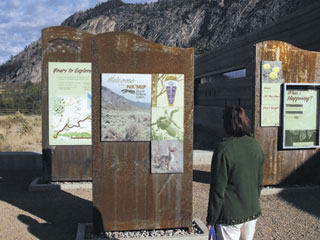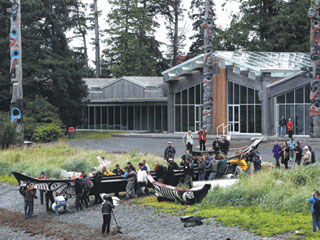Natives play big role at International Ecotourism Conference
By Hans Tammemagi, Today correspondent
The Spakwus Slolem (Eagle Song) dancers of the Squamish Nation, British Columbia, which includes the area north of Vancouver, opened the conference. Bob Baker, their spokesperson and an elder, welcomed conference attendees and introduced the dance by telling how the Squamish territory is blessed with eagles.
In the opening plenary session, Kelly Bricker, executive director of the International Ecotourism Society said many people don’t realize the size and importance of the tourism industry. “It is the largest business sector in the world economy and is responsible for 230 million jobs.”
 |
| The N’Kmip Desert Cultural Centre in Osoyoos, British Columbia is one of the First Nations centers that look to ecotourism to increase awareness and knowledge of the aboriginal communities. |
If tourism were a country it would have
the second largest economy in the globe, second only to the United States.
But tourism has a large environmental impact, especially from the
transportation needed to get to and from destinations. The niche area of
ecotourism, which strives to minimize this impact, has been growing three
times faster than regular tourism.
Clearly, conferences dedicated to promoting ecotourism are important. It
is also becoming recognized that Native people, with value systems rooted
in the environment, have much to contribute. For this reason, one of the
four main themes of the conference was devoted to Indigenous People and
Local Communities; the other themes were Tourism and Climate Change, Parks
and Protected Areas and Greening Operations and Technologies.
Much discussion at the sessions was aimed at defining exactly what
ecotourism, sustainable tourism, nature tourism and similar terms mean,
and developing formal guidelines to implement them. A keynote luncheon
speaker, Anna Pollock, reprimanded the audience, saying that this is
wasting time. Instead she said we should recognize that ecotourism is all
about caring. She urged everyone to spend less time on definitions, and
get down to making things happen.
The crucial importance of caring for the environment was best stated by
Chief Bill Cranmer of the Namgis Nation from Alert Bay near northeastern
Vancouver Island. He was part of the internationally renowned Gwa’wina
Dancers who drummed, danced and performed the songs of all the birds that
fly in the sky and all the creatures that swim in the sea. Sometimes the
dancers wore large cedar masks; one depicted the supernatural thunderbird
and another was a sleek killer whale.
When the dancing ended, Cranmer delivered an impromptu and emotional
speech. “The salmon are disappearing, and without the salmon the grizzlies
and eagles won’t survive.” He described how overfishing, destruction of
spawning rivers by logging and sea lice from farmed fish are killing wild
salmon. “Everything is connected, so our people won’t survive. None of us
will survive. We must protect the environment before it’s too late.”
Although Canadian First Nations and their issues were represented at the
conference, none of the sessions included presentations by American
Indians. Several attendees mentioned that a North American conference
dedicated solely to Native ecotourism would be useful.
The importance of Native peoples’ culture was addressed by keynote speaker
Dr. Wade Davis, an anthropologist and explorer in residence at National
Geographic magazine who has studied cultures of indigenous people around
the globe. He eloquently explained how cultures and languages are treasure
houses of knowledge and that they must be protected.
In Canada, few have done more to restore Native culture than William
Wasden Jr., the leader and founder of the Gwa’wina Dancers. Not only do
their performances bring tourists to Alert Bay, but it encourages Native
youth to learn their culture and language and to stay at home. Elder
Wasden believes, “This is where the real reward lies. It cannot be
measured in dollars. But young people becoming proud of their heritage and
helping to preserve it brings great wealth to our people.”
But Native ecotourism still faces challenges. Daniel-Paul Bork, a Mohawk
Native from Oka Quebec and the CEO of Aboriginal Tourism Canada, explained
that, to date, most Native tourism developments in central and eastern
Canada have involved casinos, resorts and golf courses.
“These facilities provide income and jobs, but they do nothing for our
culture or for the environment.” Over the past few years Aboriginal
Tourism Canada has begun to pursue ecotourism. “This is important, our
traditional teaching, values and philosophy all are based on living in
harmony with nature. Ecotourism is a natural for us.”
British Columbia First Nations are leading the way in Canada. Brenda
Ireland, Neenokasi, or Hummingbird, of the Ojibway Nation, described the
work of Aboriginal Tourism British Columbia. Their programs include
newsletters, training programs, assistance with starting ecotourism
projects such as tours, marketing help, the preparation of an aboriginal
tourism destination map and a Web site.
Ireland described how, in the past few years, seven cultural centers have
opened in British Columbia that are like museums showcasing Native history
and culture, including performance halls with dancing and plays and
carving sheds for making masks, totems and canoes. These centers not only
attract tourists, but have also become cultural focal points for the
Native communities and serve as places for teaching.
|
Native cultural centers in British Columbia include: •
Squamish Lil’wat Cultural
Centre, Whistler. |
The U’Mista Cultural Centre at Alert Bay, for example, is an attractive
building located next to an abandoned residential school. The main display
preserves the treasures including masks, coppers and jewellery seized by
the federal government in 1921 at an “illegal” potlatch; these artifacts
were returned in recent years. Traditional dances are held at the nearby
Big House.
The conference sessions noted that Native people still face many
difficulties in implementing ecotourism – marketing is difficult, not
enough visitors are coming to the cultural centers, it is difficult to get
training, it is difficult to instil an entrepreneurial spirit in young
people and there is still too much red tape and bureaucracy.
© 1998 - 2009 Indian Country Today. All Rights Reserved To subscribe or visit go to: http://www.indiancountry.com
